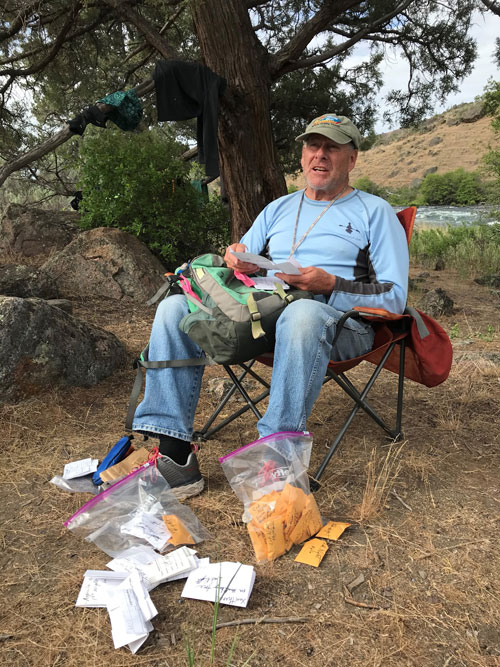“You noticed all the dead trees on the left side of the river,” said Roger. The syntax created a question, but his tone suggested a statement. I instantly looked to the left bank, eyes wide. I had noticed many things on our first day’s float down the Lower Deschutes in Oregon: the dramatic basalt cliffs, the lush sagebrush hillsides, the swirling clouds. Yet I had not noticed the left side of the river had a significantly higher number of dead trees than the right. How could I have missed that?
“Let’s theorize,” he said invitingly.

Roger Rosentreter is a 68-year-old world-famous lichenologist and renowned botanist. He is also an incredible kayaker who styles an old-school Pirouette that might actually be the same age as him. He has no padding attached to the hard plastic seat in his boat, he tells devastating environmental stories, laughs easily, and his favorite phrase has got to be, “Let’s theorize.”
We took a second to hypothesize in our heads before presenting our partial theory to Professor Rosentreter. “Well,” I started, my heart racing just a little bit, not wanting to answer wrong in front of the class, despite “class” being a riverside chair circle composed of people I know, love, and am related to. “The right side is Bureau of Land Management and National Grassland, and the left side is Reservation, so maybe they are managed differently?”
“Yeah,” Riely uptook, “Does one side have more cattle activity that weakens the riparian zone, changing how solid the banks are?” Roger silently took it in, nodding his head. Casey tossed out the flood that happened a few years back, and dad drew a salient connection between the two. We untangled our ideas and made informed guesses supported by the world around us. Roger’s astute observation skills brought many data points he collected from nature to the table.
After a rich discussion, I wanted to know! I impatiently demanded, “Well, what’s the answer?!”
Turns out Roger didn’t know. This surprised me. Unlike in science class, we weren’t guessing what the teacher already knew: we were figuring it out together. Roger had his own idea, yes, but he didn’t know for sure. We brainstormed in a dialogic space and we watched his top hypothesis evolve before our eyes.

An hour later, while eating strawberry shortcake and discussing something wildly different, Roger gasped and marched through the chair circle, led by his midair fork, proclaiming, “Look at this syringa!”
He took his bowl to the riverside plant and pointed out a growth different from the other branches. “This is evidence for my first hypothesis,” he announced. It took some explanation for us students to connect the dots.
Roger posed a number of questions that trip. He taught us a lot about lichen, botany, and environmental management. He demonstrated curiosity and wonder.
Anytime we couldn’t find Roger, we could count on him wandering back into camp an hour or two later with a gallon-size Ziploc filled with little white and brown sample envelopes. He’d tell us about the lichens he found and questions they made him ask, inevitably followed by, “Let’s theorize.”

Evening walks were not about the distance covered, but about the new knowledge gained. Roger is an investigator, and nature is full of evidence. He reminded us that nature holds more than just beautiful cliffs and idyllic skyscapes. Walking through the world like Roger means fostering a greater connection to the land. It means curiosity and inquiry. It means experiencing the power of childlike wonder. It means missing less.
We never decided for sure what was causing the dead trees to be more prominent on the left side of the river. In fact, we had a number of hypotheses still open for debate. It didn’t matter. What mattered is, because of Roger, we started looking for questions and we asked nature for answers. We looked harder, and we listened more deeply. We started to see the land for all it could teach us. And it made everything more vivid.
Photos: Casey Pagels and Jeff Wilhelm
The post Be Like Roger: Exploring Nature through a Different Lens appeared first on OARS.


Recent Comments